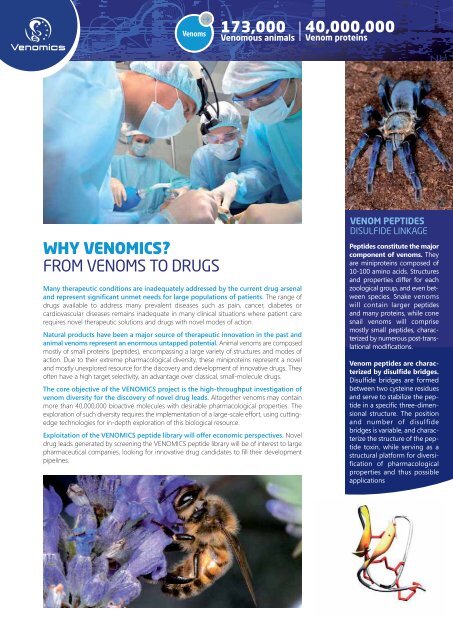plaquette venomics pdf
plaquette venomics pdf
plaquette venomics pdf
You also want an ePaper? Increase the reach of your titles
YUMPU automatically turns print PDFs into web optimized ePapers that Google loves.
Venoms<br />
WHY VENOMICS?<br />
FROM VENOMS TO DRUGS<br />
Many therapeutic conditions are inadequately addressed by the current drug arsenal<br />
and represent significant unmet needs for large populations of patients. The range of<br />
drugs available to address many prevalent diseases such as pain, cancer, diabetes or<br />
cardiovascular diseases remains inadequate in many clinical situations where patient care<br />
requires novel therapeutic solutions and drugs with novel modes of action.<br />
Natural products have been a major source of therapeutic innovation in the past and<br />
animal venoms represent an enormous untapped potential. Animal venoms are composed<br />
mostly of small proteins (peptides), encompassing a large variety of structures and modes of<br />
action. Due to their extreme pharmacological diversity, these miniproteins represent a novel<br />
and mostly unexplored resource for the discovery and development of innovative drugs. They<br />
often have a high target selectivity, an advantage over classical, small-molecule drugs.<br />
The core objective of the VENOMICS project is the high-throughput investigation of<br />
venom diversity for the discovery of novel drug leads. Altogether venoms may contain<br />
more than 40,000,000 bioactive molecules with desirable pharmacological properties. The<br />
exploration of such diversity requires the implementation of a large-scale effort, using cuttingedge<br />
technologies for in-depth exploration of this biological resource.<br />
Exploitation of the VENOMICS peptide library will offer economic perspectives. Novel<br />
drug leads generated by screening the VENOMICS peptide library will be of interest to large<br />
pharmaceutical companies, looking for innovative drug candidates to fill their development<br />
pipelines.<br />
><br />
173,000<br />
Venomous animals<br />
40,000,000<br />
Venom proteins<br />
VENOM PEPTIDES<br />
DISULFIDE LINKAGE<br />
Peptides constitute the major<br />
component of venoms. They<br />
are miniproteins composed of<br />
10-100 amino acids. Structures<br />
and properties differ for each<br />
zoological group, and even between<br />
species. Snake venoms<br />
will contain larger peptides<br />
and many proteins, while cone<br />
snail venoms will comprise<br />
mostly small peptides, characterized<br />
by numerous post-translational<br />
modifications.<br />
Venom peptides are characterized<br />
by disulfide bridges.<br />
Disulfide bridges are formed<br />
between two cysteine residues<br />
and serve to stabilize the peptide<br />
in a specific three-dimensional<br />
structure. The position<br />
and number of disulfide<br />
bridges is variable, and characterize<br />
the structure of the peptide<br />
toxin, while serving as a<br />
structural platform for diversification<br />
of pharmacological<br />
properties and thus possible<br />
applications


